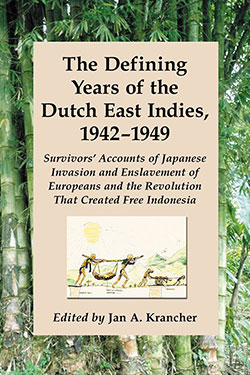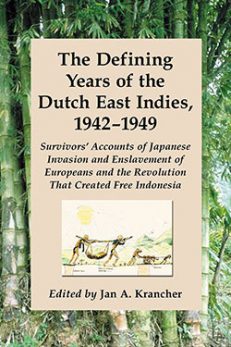The Defining Years of the Dutch East Indies, 1942–1949
Survivors’ Accounts of Japanese Invasion and Enslavement of Europeans and the Revolution That Created Free Indonesia
$29.95
In stock
About the Book
Following their invasion of Java on March 1, 1942, the Japanese began a process of Japanization of the archipelago, banning every remnant of Dutch rule. Over the next three years, more than 100,000 Dutch citizens were shipped to Japanese internment camps and more than four million romushas, forced Indonesian laborers, were enlisted in the Japanese war effort.
The Japanese occupation stimulated the development of Indonesian independence movements. Headed by Sukarno, a longtime admirer of Japan, nationalist forces declared their independence on August 17, 1945. For Dutch citizens, Dutch-Indonesians or “Indos,” and pro-Dutch Indonesians, Sukarno’s declaration marked the beginning of a new wave of terror. These powerful and often poignant stories from survivors of the Japanese occupation and subsequent turmoil surrounding Indonesian independence provide one with a vivid portrait of the hardships faced during the period.
About the Author(s)
Bibliographic Details
Edited by Jan A. Krancher
Format: softcover (5.5 x 8.5)
Pages: 288
Bibliographic Info: chronology, glossary, appendix, index
Copyright Date: 2003 [1996]
pISBN: 978-0-7864-1707-0
eISBN: 978-0-7864-8106-4
Imprint: McFarland
Table of Contents
Preface 1
Introduction 5
1. Andrew A. van Dyk 11
Overview of the Imprisonment Experience
2. Frans J. Nicolaas Ponder 25
A Soldier in the Royal Netherlands-Indies Army
3. Willem Wanrooy 39
A Letter to My Grandson
4. Arthur Stock 43
A British Prisoner of War
5. Anton Acherman 56
Glimpses of Camp Life
6. Johannes Vandenbroek 64
A Teacher Turned Soldier and Imprisoned by the Japanese
7. William H. Maaskamp 71
A Dutch Youth Tortured and Imprisoned by the Japanese, Then Pressed into Service
Against Indonesian Freedom Fighters
8. Denis Dutrieux 85
“They Can’t Be Human Beings!’”
9. Mathilde Ponder-van Kempen 98
A Wartime Girlhood
10. Barend A. van Nooten 103
The Mouse-Deer and the Tiger
11. Willy Riemersma-Philippi 117
Imprisoned in Our Own Home
12. Maria McFadden-Beek 126
Ode to My Mother
13. Karel Senior 133
New Terror on the Way Home
14. Hendrik B. Babtist 148
The Protectors Abandoned Us
15. Pieter Groenevelt 155
The Bombs That Saved My Life
16. Jan Vos 162
Memories of an Indo Boy
17. Feite Posthumus 175
An Unlikely Friendship
18. K.A. Peter van Berkum 188
Saved by a Stranger
19. Rita la Fontaine-de Clercq Zubli 196
Disguised as a Boy
20. Greta Kwik 214
The Loss of My Father
21. Gerda Dikman-van den Broek 225
Innocence Denied
22. J. Alexandra Humphrey-Spier 234
Never to See the Land of My Birth Again
23. Amani J. Fliers-Hoeke 249
The Missing Years
24. Joyce F. Kater-Hoeke 252
Liberated, Yet Not Free
Appendices
I. Chronological Summary of Events in the Former Dutch East Indies from December 3, 1941, to December 31, 1942 257
II. Foreign Terms and Abbreviations 262
III. Mortality Statistics of Civilian Internees 263
IV. New Versus Old Indonesian Placenames 268
Index 271
Book Reviews & Awards
- “Captures the nightmarish drama of the physical and political landscape of Indonesia under Japanese rule with a number of scenes possessing extraordinary cinematic potential. The first-person narrative employed is more riveting, vigorous, and credible than if the stories were told in the more conventional third-person historical text. This unusual and moving compilation richly augments the existing canon of literature”—TEMPO
- “Excellent translating and editing”—Sandra Phelps
- “A must-read…most thorough”—Bernice Harapat-Terluin
- “Reading these pages is a journey that leaves an indelible impression as well as an understanding of the importance of this relatively small piece of history”—Internee Affairs
- “An unusual collection of 24 personal stories…accounts that engage the reader emotionally. There is much to be learned from this important book. These are wonderfully instructive pages”—Cenografix
- “Highly recommended”—Argunners Magazine





